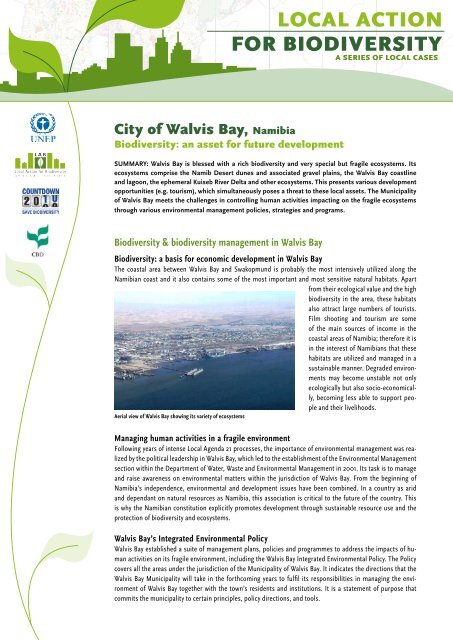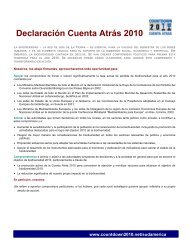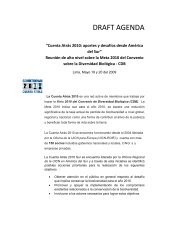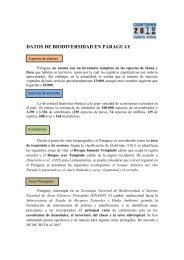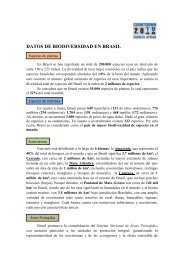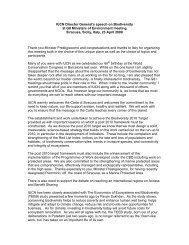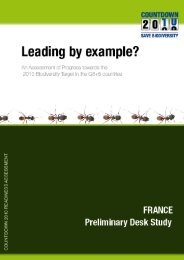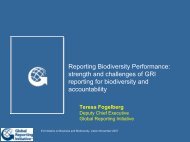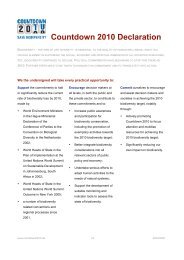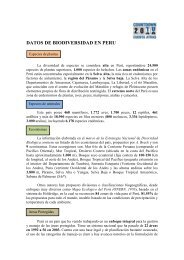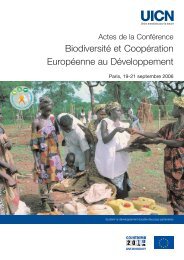City of Walvis Bay, Namibia - Biodiversity - UNEP
City of Walvis Bay, Namibia - Biodiversity - UNEP
City of Walvis Bay, Namibia - Biodiversity - UNEP
You also want an ePaper? Increase the reach of your titles
YUMPU automatically turns print PDFs into web optimized ePapers that Google loves.
Local Action<br />
for <strong>Biodiversity</strong><br />
A series <strong>of</strong> local cases<br />
<strong>City</strong> <strong>of</strong> <strong>Walvis</strong> <strong>Bay</strong>, <strong>Namibia</strong><br />
<strong>Biodiversity</strong>: an asset for future development<br />
SUMMARY: <strong>Walvis</strong> <strong>Bay</strong> is blessed with a rich biodiversity and very special but fragile ecosystems. Its<br />
ecosystems comprise the Namib Desert dunes and associated gravel plains, the <strong>Walvis</strong> <strong>Bay</strong> coastline<br />
and lagoon, the ephemeral Kuiseb River Delta and other ecosystems. This presents various development<br />
opportunities (e.g. tourism), which simultaneously poses a threat to these local assets. The Municipality<br />
<strong>of</strong> <strong>Walvis</strong> <strong>Bay</strong> meets the challenges in controlling human activities impacting on the fragile ecosystems<br />
through various environmental management policies, strategies and programs.<br />
<strong>Biodiversity</strong> & biodiversity management in <strong>Walvis</strong> <strong>Bay</strong><br />
<strong>Biodiversity</strong>: a basis for economic development in <strong>Walvis</strong> <strong>Bay</strong><br />
The coastal area between <strong>Walvis</strong> <strong>Bay</strong> and Swakopmund is probably the most intensively utilized along the<br />
<strong>Namibia</strong>n coast and it also contains some <strong>of</strong> the most important and most sensitive natural habitats. Apart<br />
from their ecological value and the high<br />
biodiversity in the area, these habitats<br />
also attract large numbers <strong>of</strong> tourists.<br />
Film shooting and tourism are some<br />
<strong>of</strong> the main sources <strong>of</strong> income in the<br />
coastal areas <strong>of</strong> <strong>Namibia</strong>; therefore it is<br />
in the interest <strong>of</strong> <strong>Namibia</strong>ns that these<br />
habitats are utilized and managed in a<br />
sustainable manner. Degraded environments<br />
may become unstable not only<br />
ecologically but also socio-economically,<br />
becoming less able to support people<br />
and their livelihoods.<br />
Aerial view <strong>of</strong> <strong>Walvis</strong> <strong>Bay</strong> showing its variety <strong>of</strong> ecosystems<br />
Managing human activities in a fragile environment<br />
Following years <strong>of</strong> intense Local Agenda 21 processes, the importance <strong>of</strong> environmental management was realized<br />
by the political leadership in <strong>Walvis</strong> <strong>Bay</strong>, which led to the establishment <strong>of</strong> the Environmental Management<br />
section within the Department <strong>of</strong> Water, Waste and Environmental Management in 2001. Its task is to manage<br />
and raise awareness on environmental matters within the jurisdiction <strong>of</strong> <strong>Walvis</strong> <strong>Bay</strong>. From the beginning <strong>of</strong><br />
<strong>Namibia</strong>’s independence, environmental and development issues have been combined. In a country as arid<br />
and dependant on natural resources as <strong>Namibia</strong>, this association is critical to the future <strong>of</strong> the country. This<br />
is why the <strong>Namibia</strong>n constitution explicitly promotes development through sustainable resource use and the<br />
protection <strong>of</strong> biodiversity and ecosystems.<br />
<strong>Walvis</strong> <strong>Bay</strong>’s Integrated Environmental Policy<br />
<strong>Walvis</strong> <strong>Bay</strong> established a suite <strong>of</strong> management plans, policies and programmes to address the impacts <strong>of</strong> human<br />
activities on its fragile environment, including the <strong>Walvis</strong> <strong>Bay</strong> Integrated Environmental Policy. The Policy<br />
covers all the areas under the jurisdiction <strong>of</strong> the Municipality <strong>of</strong> <strong>Walvis</strong> <strong>Bay</strong>. It indicates the directions that the<br />
<strong>Walvis</strong> <strong>Bay</strong> Municipality will take in the forthcoming years to fulfil its responsibilities in managing the environment<br />
<strong>of</strong> <strong>Walvis</strong> <strong>Bay</strong> together with the town’s residents and institutions. It is a statement <strong>of</strong> purpose that<br />
commits the municipality to certain principles, policy directions, and tools.
Dune Protection and Management<br />
The Dune Belt Management Plan and Regulations were developed to promote sustain-able<br />
utilization and improve environmental protection in the Dune Belt Area. The<br />
primary challenges to managing and protecting the dune ecosystems are disturbances<br />
caused by irresponsible recreational activities <strong>of</strong> which the most damaging is <strong>of</strong>f-road<br />
driving. Zoning <strong>of</strong> the area for specific uses is one <strong>of</strong> the key strategies addressed by the<br />
Dune Belt Management Plan and Regulations to achieve better regulation <strong>of</strong> activities<br />
within the entire dune belt area. The responsibility <strong>of</strong> managing the Dune Belt Area has<br />
now been assigned to the Ministry<br />
<strong>of</strong> Environment and Tourism.<br />
Coastline Strategic<br />
Environmental Assessment<br />
<strong>Walvis</strong> <strong>Bay</strong>’s Coastline Strategic Environmental<br />
Assessment (CSEA) for the<br />
coastline between <strong>Walvis</strong> <strong>Bay</strong> and Swakopmund<br />
provides protection <strong>of</strong> the<br />
coastline environment and guides the<br />
Municipal Council in decision-making,<br />
integrating environmental and urban<br />
planning and development issues. The<br />
CSEA also promotes sustainable development<br />
and awareness.<br />
For more info on this project, contact:<br />
David Uushona or Olavi Makuti<br />
www.walvisbaycc.org.na<br />
Involvement in<br />
international initiatives<br />
<strong>Walvis</strong> <strong>Bay</strong> Mayor, Derek Klazen (with David Uushona in the<br />
background), signing a pledge supporting the <strong>Walvis</strong> <strong>Bay</strong><br />
Local Action 21 programme’s revised Integrated Environmental<br />
Policy<br />
The Municipality <strong>of</strong> <strong>Walvis</strong> <strong>Bay</strong>, an<br />
ICLEI member city, is one <strong>of</strong> only<br />
five African municipalities participating<br />
in ICLEI’s Local Action for <strong>Biodiversity</strong> (LAB) Project. According to David Uushona<br />
(Manager: Solid Waste and Environmental Management) the LAB status is an important<br />
achievement for <strong>Walvis</strong> <strong>Bay</strong>. “As you know the municipality has implemented and<br />
successfully managed the Local Agenda 21 target goals, through various environmental<br />
awareness and conservation initiatives. Being recognised as an LAB city underscores not<br />
only our efforts to create more awareness <strong>of</strong> environmental issues, but also signals the<br />
high regard international organisations like ICLEI have for the work we have been doing<br />
in our port city” says Uushona.<br />
<strong>City</strong> contacts & pr<strong>of</strong>ile<br />
Resourceful biodiversity management with limited<br />
capacity in perhaps the driest city in the<br />
world.<br />
The <strong>City</strong> <strong>of</strong> <strong>Walvis</strong> <strong>Bay</strong>, with a population <strong>of</strong> about 60,000, is situated between the<br />
Namib Desert and Atlantic Ocean, on the west coast <strong>of</strong> <strong>Namibia</strong>. It lies between the Swakop<br />
River in north and the Namib Desert sand dunes and gravel plains to the east with<br />
its boundary extending to the Namib Naukluft Park. To the south are the 12,600 hectare<br />
<strong>Walvis</strong> <strong>Bay</strong> wetland and the adjoining delta <strong>of</strong> the ephemeral Kuiseb River in the south.<br />
The <strong>Walvis</strong> <strong>Bay</strong> Lagoon has been proclaimed a RAMSAR site, and is one <strong>of</strong> southern<br />
Africa’s richest and coastal wetlands, supporting up to 250,000 birds in peak summer<br />
season.<br />
Name: David Uushona, Manager, or Olavi Makuti, Environmental Officer<br />
Department: Water, Waste & Environmental Management<br />
E-mail: duushona@walvisbaycc.org.na or omakuti@walvisbaycc.org.na<br />
Website: www.walvisbaycc.org.na<br />
Local Action for <strong>Biodiversity</strong> is a global urban biodiversity initiative <strong>of</strong> ICLEI – Local Governments for Sustainability in cooperation with IUCN. This pilot project<br />
<strong>of</strong> 21 cities around the globe focuses on the key roles that local governments play in conserving the worlds biodiversity and retaining the relationship between people and nature.<br />
See: www.iclei .org/lab; lab@iclei .org<br />
Countdown 2010 is a powerful network <strong>of</strong> more than 600 partners working together towards the 2010 biodiversity target. Each partner commits additional efforts to tackle the<br />
causes <strong>of</strong> biodiversity loss. The secretariat – hosted by the International Union for Conservation <strong>of</strong> Nature (IUCN) – facilitates and encourages action, promotes the importance <strong>of</strong> the 2010<br />
biodiversity target and assesses progress towards 2010. See: www.countdown2010.org<br />
Cities & <strong>Biodiversity</strong> is an initiative <strong>of</strong> local governments and UN agencies to increase awareness on the relevant role <strong>of</strong> cities and towns for conserving and managing biodiversity.<br />
See: www.iclei.org/biodiversity<br />
The “Cities & <strong>Biodiversity</strong> Case Series” is started in 2008 on the occasion <strong>of</strong> the UNCBD Conference <strong>of</strong> the Parties (COP) 9 in Bonn/Germanyin May 2008. Funding is<br />
provided by <strong>UNEP</strong>, with co-funding from ICLEI, IUCN and the <strong>City</strong> <strong>of</strong> Bonn. The case descriptions are compiled by the “Local Action for <strong>Biodiversity</strong> (LAB)” project team in the ICLEI Africa<br />
Secretariat and ICLEI‘s International Training Centre.<br />
© ICLEI, 2008. Pictures, texts and quotes are free <strong>of</strong> use with a reference to this source.<br />
www.iclei.org/biodiv-2008<br />
www.unep.org/urban_environment May 2008


